How and what to feed raspberries?
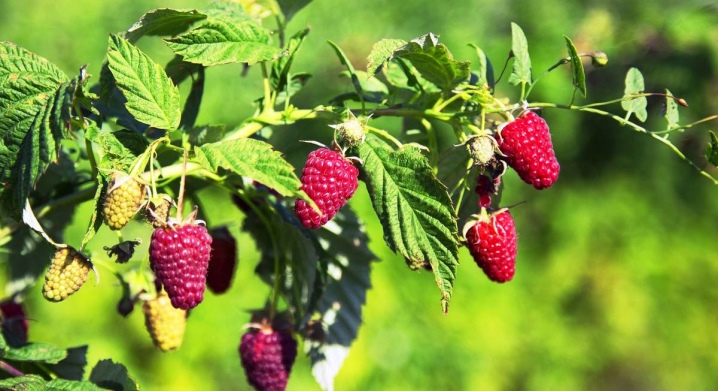
Raspberries are considered a fairly unpretentious fruit and berry crop. But in order for it to grow well on the personal plot and give a good harvest, it needs fertilizers. In our article we will understand the rules for feeding raspberries.
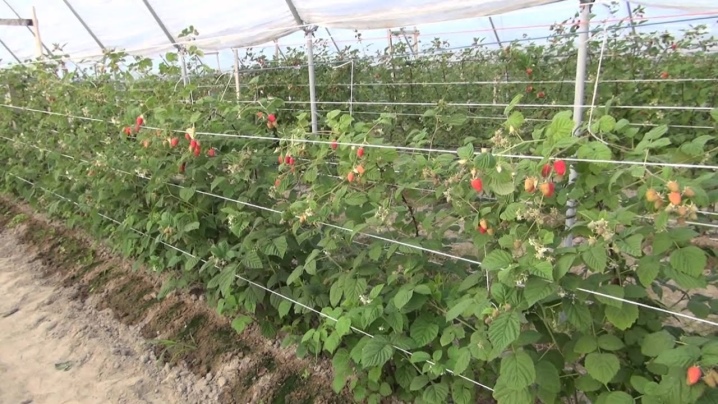
Why is this needed?
The main task of any top dressing is to enrich the soil with useful micro and macro elements, thanks to which the plants receive all the necessary nutrients from the substrate. Timely application of dressings greatly improves the condition of the plant, stimulates an increase in yield and an improvement in the taste characteristics of fruits. However, an increase in fruiting is far from the only reason why plants may need feeding. So, additional fertilization may be needed for raspberries in the following cases:
- when the harsh winter cold caused significant damage to the shoots;
- if there is an excess or deficiency of individual microelements in the soil;
- if the raspberry tree is badly damaged during the heat and drought.
In addition, raspberries are required for feeding if they grow on poor soils.
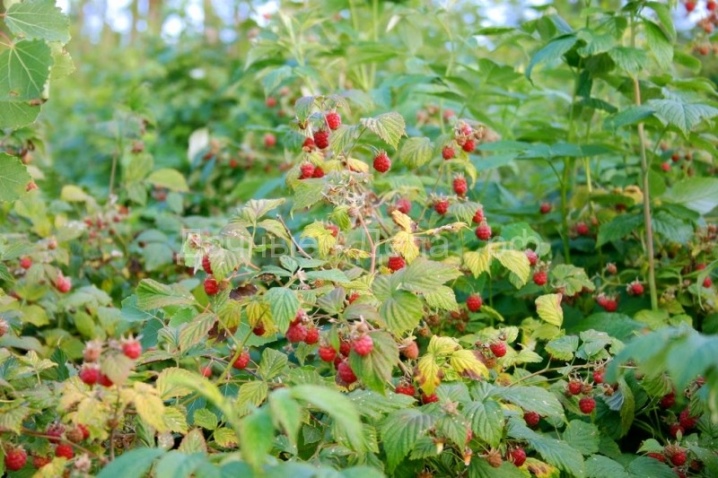
Signs of a lack of nutrition
There are several characteristic symptoms by which the grower can determine that the plant needs an additional serving of micronutrients. Signs can occur either separately or all at once:
- the bush grows too slowly, the stems weaken and become thinner;
- the leaves are getting smaller;
- leaves completely or partially change their shade: they become yellow, brown or turn pale.
It is possible to determine which minerals are lacking in raspberries by its appearance. For example, if it is low in nitrogen, then it begins to grow very slowly, internodes grow short - less than 10 cm, and the leaves acquire a pale green color. An excess of this mineral, on the contrary, leads to accelerated growth of shoots and green mass, which most negatively affects the size of the fruit.
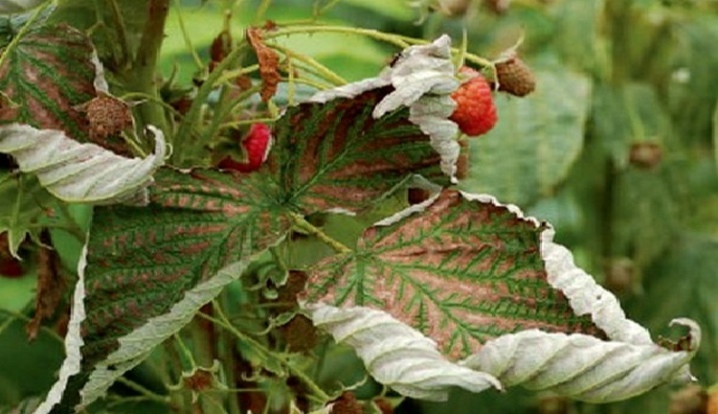
If raspberries lack potassium, their leaves turn brown, their edges curl, and the berries dry out and completely lose their taste. Due to the lack of phosphorus, the root system primarily suffers, this causes thinning of the stems - they become dry and brittle, the leaves acquire a dark green color, the berries are unevenly stained. The lack of magnesium is indicated by the yellowing of the center of the leaf plates, while the taste of the berry becomes rather mediocre.
If the leaves turn yellow, but the veins remain bright green, this indicates an iron deficiency.
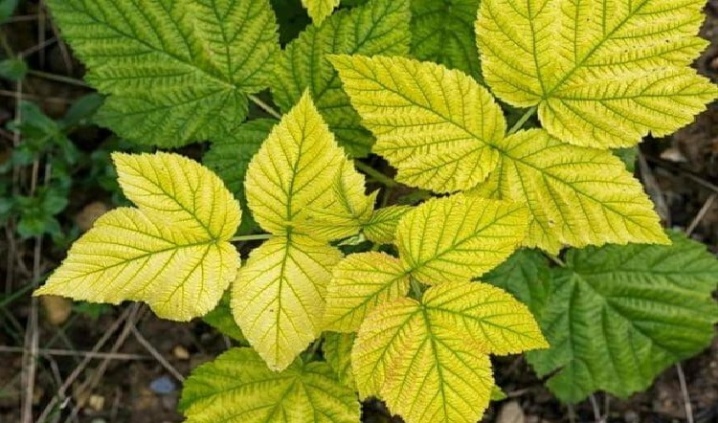
How to fertilize?
For the full growth and development of raspberries, the following minerals are required.
- Nitrogen - the volume of consumption of this microelement is 40-100 kg / m2. Nitrogen is contained in urea, better known as carbamide - it contains more than 45% of the trace element. Such a mineral fertilizer can be used on all types of soil, the only drawback of using urea is the prohibition of mixing it with any alkaline substances such as limestone, chalk or ash. Ammonium nitrate has become widespread among gardeners, the nitrogen content in it varies from 25 to 35%. In addition, it contains about 10% sulfur, which greatly improves the assimilation of nitrogen by living cultures.
- Phosphorus - the volume of absorption of a trace element by raspberries is relatively small, no more than 7 kg / m2.However, its digestibility is largely influenced by the acidity of the soil - the application rate is considered to be about 10 g per 1 kg of water.
- Potassium - this trace element is very important for the plant at the stage of fruit setting. At this stage, raspberries require about 5 g of potassium per square meter. Even a slight deficiency of this microelement significantly reduces the growth rate of young shoots.
- Very often gardeners and gardeners use combined fertilizer nitroammophosphate, nitrogen is included in its composition, as well as potassium and phosphorus in equal proportions - such a concentration determines a nutritious and healing effect, improves the condition of raspberries and the nutritional value of the soil. Nitroammophoska can be used on any type of substrate.
- Raspberries are required magnesium supplements... In the soil intended for planting this culture, there should be about 10 g per square meter.
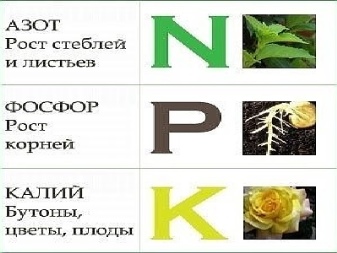
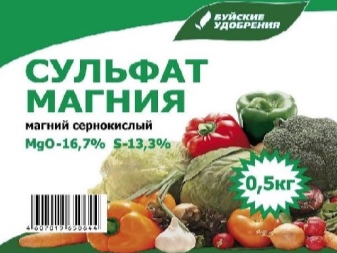
Instead of mineral fertilizers, organic matter can be used to feed raspberries, it contains all the necessary micro and macro elements that the plant needs for the development and formation of tasty and large fruits.
Nitrogen is especially abundant in organic matter. Most often, gardeners use these options.
- Humus - represents a thoroughly rotted manure without a specific unpleasant odor, this fertilizer is evenly scattered over the raspberries or embedded in the soil.
- Bird droppings, mullein, or horse dung - these formulations are used in liquid form as an aqueous infusion. It is very simple to make it - 1/4 of the bucket is filled with organic matter, filled with water and left for a week. During this time, the infusion will ferment, so you need to stir it periodically. The resulting liquid should be diluted before use in a ratio of 1 to 10, if we are talking about bird droppings - then 1 to 20. Water the raspberry tree at the rate of 1 bucket / m2.
- Infusion of weeds - especially useful for raspberry nettles and wheatgrass. The leaves and stems of weeds are chopped, crushed and poured with cool water, after which they are sent for fermentation in a warm place. After 7 days, the resulting solution is diluted with water in a ratio of 1 to 5, the watering rules are the same as for the mullein.


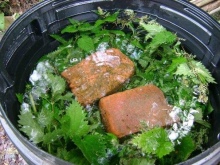
When to feed?
Raspberry bushes are fertilized three times per season.
In the spring
The introduction of spring dressings is carried out in the last decade of April, when the buds begin to swell, or at the very beginning of May - at the stage of the appearance of the first leaves. At this stage, raspberries require 3 types of dressings: superphosphate, potassium salts, and nitrogen preparations. Superphosphates give raspberries the strength to form young shoots. Nitrogen is required for a crop to grow leaf mass, so it must be added to the ground at the very first spring pre-sowing soil treatment. Potassium helps to increase the immunity of the plant, allows the bushes to survive recurrent frosts and droughts.
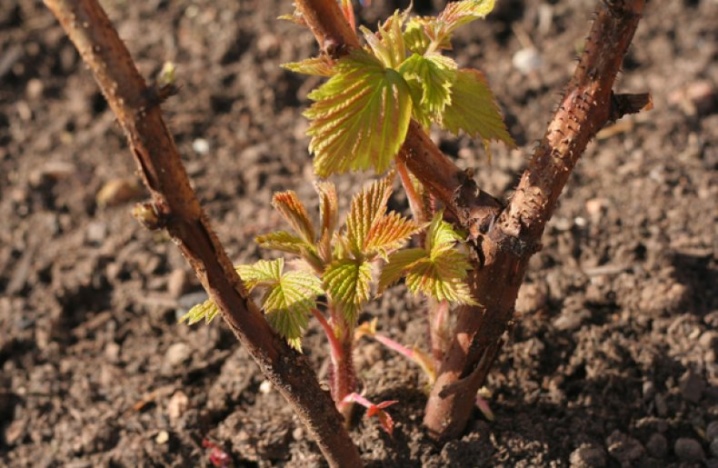
For the winter
In winter, the last seasonal feeding of the raspberry is carried out, this is usually done in November - after the final harvest. During this period, fertilization allows the plant to better prepare for wintering, and in addition, fertilization at this stage stimulates the formation of buds for the new season.
We draw your attention to the fact that in the autumn period it is forbidden to introduce nitrogen-containing compounds, since they will stimulate active vegetation. As a result, the plant will not go into a dormant state and will not be able to withstand the onset of frost.
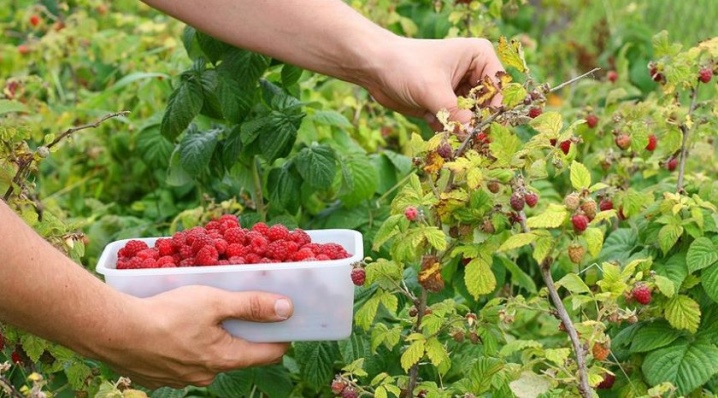
Summer
In summer, great attention is paid to foliar feeding. It has rather an auxiliary value and is intended to saturate the plants with the necessary microelements through the aerial part. Nevertheless, foliar feeding should not be neglected - this is a great way to add nutrients in emergency situations, for example, in the presence of pests, damage to the root system or in the case when the soil is excessively wet due to prolonged rains.However, you should not forget about root feeding. Their main goal in June-August is to increase yields, increase the number of ovaries and quickly ripen fruits, improve their taste characteristics.
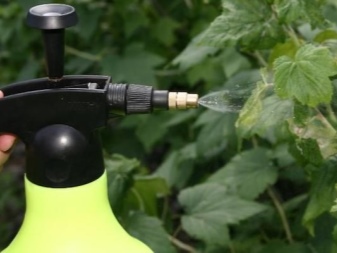
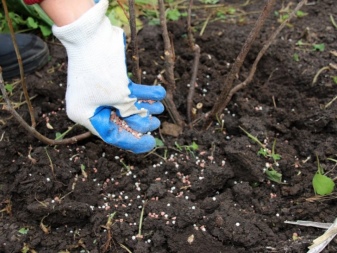
Fertilization chart
In order for raspberries to be useful, they must be introduced exactly according to the scheme, taking into account the peculiarities of the development of the culture during different periods of the growing season. The very first feeding is carried out at the planting stage. To do this, add 100-200 g of superphosphate and 50-80 g of potassium sulfate to each well, and add a bucket of humus - all the ingredients are mixed with the ground, and the plants are planted.
In the first year, more feeding of raspberries until autumn is not required.
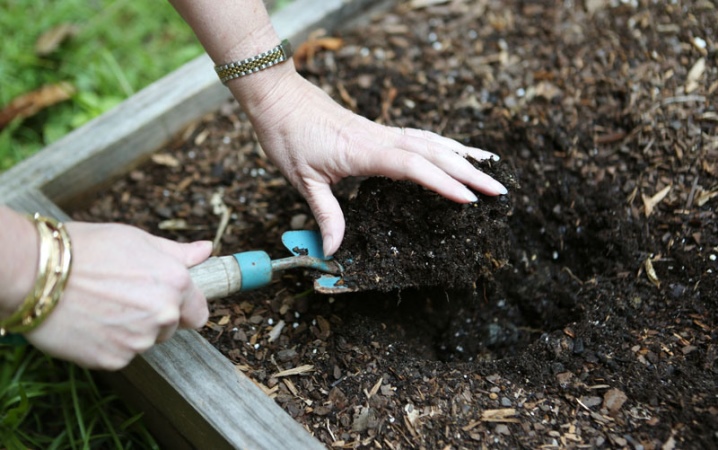
Starting in the second growing season, raspberries need to be fed every spring. At this time, the plant needs nitrogen to grow greenery. This element is found in abundance in chicken droppings and manure of farm animals, raspberries are especially fond of horse manure. - it is considered one of the best fertilizers for this crop. Slurry is prepared at the rate of 1 liter per bucket, the solution is poured into grooves formed at a distance of 30-50 cm from the bushes. If you use minerals, then you need to dilute them exactly in accordance with the instructions. Watering is carried out only on a pre-moistened substrate. During this period, you can additionally sprinkle the earth with humus at the rate of 10 kg of substance per square meter and peat, which contributes to a significant improvement in the structure of the soil.
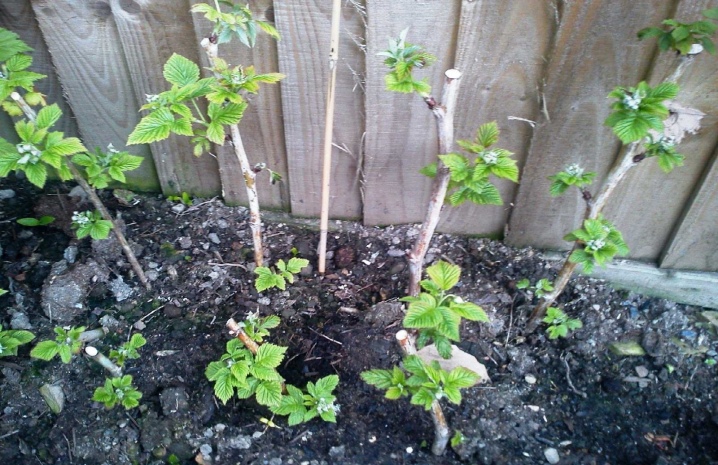
If enough nitrogen is introduced in the spring, then in the summer, raspberries will not feel the need for this trace element. During the fruiting period, the plant requires potassium, calcium, phosphorus, as well as boron and magnesium. The replacement of potassium-phosphorus complexes with ash has a very good effect, however, it is necessary to take either fresh or one that was stored in a dry place. We draw your attention to the fact that mixing of ash with organic matter or nitrogen-containing preparations is not allowed, since in this case ammonia is released, which is dangerous for plants and for people.
To fertilize raspberries, 1 glass of ash is crushed, diluted in a bucket of water and the plantings are processed.
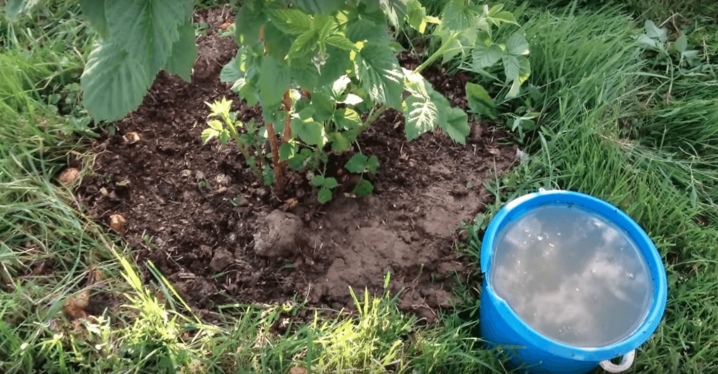
After harvesting is complete, you can start feeding raspberries in the fall. To do this, 3-4 kg of good humus must be added to the aisle, as well as 2 tbsp. l. nitrogen preparations and 4 tbsp. l. potash. In addition, during this period, you can add 50 g of complex mixtures designed specifically for raspberries. All substances are embedded in the ground, dug up and covered with mulch. Remontant raspberries require special attention - they are fed with the same chemical and folk remedies that are used to fertilize the most common varieties, but the concentration should be increased, since remontant raspberries require more trace elements in order to give a full-fledged double harvest.
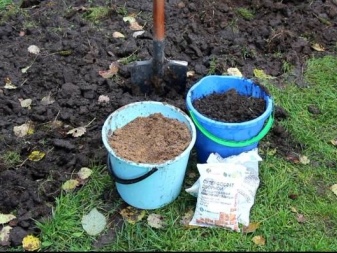
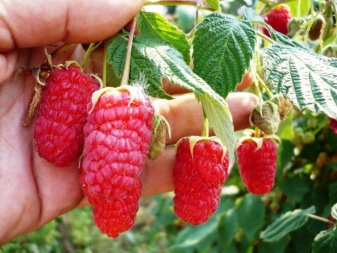
In spring time, feeding with slurry, saltpeter or urea is performed - carbamide contributes not only to plant nutrition, but also protects it from pests, the larvae of which may be in the soil. Spring processing of remontant raspberries is carried out immediately after the snow melts, it is allowed to feed with ammonia at the rate of 2-3 liters per bucket, while the liquid consumption should be 5 liters for each bush.
At the flowering stage, remontant raspberries are fertilized with herbal infusions or humus, nitrophoska or other phosphorus-potassium mixtures must be added.
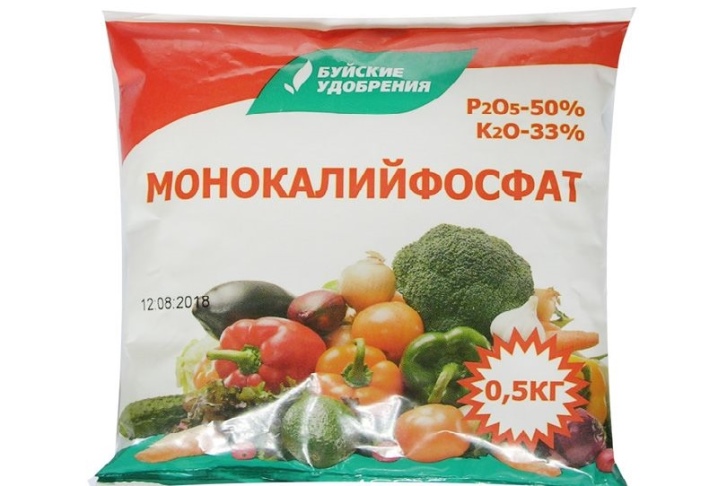
Expert advice
In conclusion, consider the most common mistakes gardeners make when feeding raspberries.
- Top dressing is introduced out of time. Each type of fertilizer has its own period, if you feed the plants before the due date or later, the raspberries simply will not be able to correctly use the received nutrients.
- Excess or shortage of fertilizers. It seems to some gardeners that the more nutrients the plant receives, the better. This is a common misconception, since an excess of micronutrients, even the most useful ones, is dangerous for the culture, as is their deficiency. For example, an excessive nitrogen content stimulates the active growth of green mass - as a result, the plant does not have the strength to form ovaries, which significantly worsens the amount of the crop obtained.
- Failure to comply with agricultural techniques. Fertilizers under the raspberry tree should be applied evenly, so that each plant receives its own portion of useful elements.
- The use of unsuitable or low quality formulations. All expired drugs must be thrown away - they are unusable, in an attempt to save on fertilizers, you risk causing irreparable damage to raspberry bushes.
- Introduction of nitrogen-containing preparations with chlorine. The fact is that chlorine is an element that raspberries categorically do not perceive. From its excessive concentration, the bushes begin to suffer from chlorosis, the first sign of this disease is yellowing of the leaves. Avoid complex formulations containing this trace element.







The comment was sent successfully.